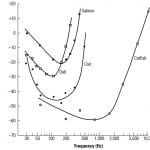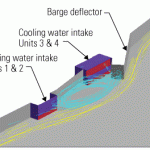Aquatic organisms in the cooling water of power plants can be injured or killed if they impinge on screens or entrain through the circulating water system. Thermal power plants can use fish protection technologies or change their operations to protect aquatic organisms. The implementation of fish protection technology at cooling water intake structures (CWIS) is regulated by Section 316(b) of the Clean Water Act (CWA), which requires that the location, design, construction, and capacity of a CWIS reflect the "best technology available" (BTA) for minimizing adverse environmental impact (AEI) on aquatic organisms.
Since the early 1970s, power plants have installed fish protection technologies largely on a case-by-case basis, with limited guidance from the U.S. Environmental Protection Agency (EPA). In 2004, the EPA published rules (the Rule) for implementing Section 316(b) of the CWA at most existing power plants. The Rule uses national performance standards (a reduction in impingement mortality of 80% to 95% and—in some cases—a reduction in entrainment of 60% to 90%, compared with a baseline) as a metric for assessing the effectiveness of compliance options.
The Rule (National Pollutant Discharge Elimination System—Final Regulations to Establish Requirements for Cooling Water Intake Structures at Phase II Existing Facilities, Federal Register 69(131): 41576-41693, July 9, 2004) is technology-based. All of the compliance options require an examination of intake design and operational measures to demonstrate that protection of aquatic organisms will meet the performance standards. Most of the compliance alternatives require a detailed evaluation of alternative technological and/or operational measures to determine the feasibility, effectiveness, and cost of compliance. Although evaluations of potential alternatives to improve fish survival are required, the EPA does not provide guidance on how to conduct them.
To help power companies determine the most cost-effective strategy for complying with Section 316(b) requirements, Alden Research Laboratory Inc.—under contract to the Electric Power Research Institute (EPRI)—has developed a method to evaluate technologies and operational changes to protect fish (see POWER, May 2004, p. 54). Several terms are used interchangeably to describe the process; at Alden, we prefer "alternative intake analysis" (AIA). Our approach is a well-developed, efficient, consistent, and technically defensible way to screen available and emerging fish protection technologies and operational measures to meet the new standards.
Before starting an evaluation, we determine if the Rule applies at a given facility and, if so, which performance standards apply. The Rule applies to existing Phase II facilities (see "What is an existing Phase II facility?"). The standards that apply at a given facility depend upon the type of body from which it withdraws water (such as a river, reservoir, or estuary), the flow characteristics of that waterbody (retention times in reservoirs or mean annual flows in rivers), and how frequently a facility generates electricity (its capacity utilization rate; see "Which standards apply?").
Preliminary screening
Prior to the detailed AIA, available alternatives are screened for a given site. From this preliminary screening, we select those options that seem practical to install and operate and have the potential to meet the performance standards. The three areas of concern in the preliminary screening are:
- Biological effectiveness.
- Engineering feasibility.
- Advantages of one alternative over another.
Because the effectiveness of fish protection technologies depends on site-specific factors, all the available information on the CWIS, the waterbody, and the biological community of the source waterbody are gathered and reviewed. During the preliminary screening, we consider the interaction between the CWIS (design and operation, plant layout details, regulatory history, existing fish protection systems, and the like) and the waterbody from which cooling water is drawn (including water quality, bathymetry, and currents) during consideration of alternatives’ effectiveness, limitations, and practicality.
We begin the review of available information with the site’s regulatory history. In some cases, existing permits may contain operational constraints to address other issues (such as thermal discharge limits) that may affect the selection of alternatives. In addition, Section 316(b) evaluations and determinations and subsequent actions taken (if any), and the result of these actions may guide decisions regarding future adoption of fish protection technologies.
During the initial screening, Alden does not consider cost. We base the selection of technologies for further consideration solely on their implementation and performance potentials.
From a biological perspective, we consider the interaction between the proposed technology and the entire biological community. For example, a 1-mm cylindrical wedgewire screen (Figure 1) may not be a viable option in waterbodies that have little or no current (such as a lake or reservoir) and are thus unable to carry away debris removed from the screens during airburst cleaning. From an engineering perspective, we eliminate those alternatives that are not feasible for installation at a specific plant. For example, if a plant is located on a dock line or shipping channel, there may not be sufficient surface water available to install a barrier net or aquatic filter barrier (AFB).
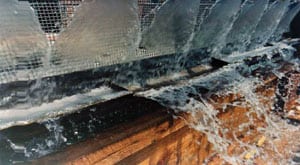
1. Tubular option. A cylindrical wedge wire screen may be one design option for complying with Section 316(b) of the Clean Water Act.
Courtesy: Johnson Screens
Finally, we compare all of the alternatives that meet the biological and engineering acceptance criteria to determine if one alternative has a distinct advantage over another. For example, when comparing two technologies that operate in a similar fashion, one may have an automated cleaning system that makes it more desirable for installation than one without a cleaning system. In some cases, a subjective professional judgment is used to make the final decision.
Much more to consider
Once we have selected the options that have the best potential for effective application, we conduct a detailed evaluation. First, we develop conceptual designs for the alternatives. Then, site-specific factors that could affect the design (such as design flows, bathymetry, species, lifestages to be protected, and icing) are evaluated.
Design considerations. Based on available information, we develop design evaluation criteria. The criteria define features necessary for acceptable plant application and operation and help to identify any fatal flaws. If specific data on these factors are not available, field studies may be required to acquire them.
Plant design and operational features have an obvious role in the development and location of alternative intakes. Plant operating personnel should be included in this part of the process to identify, obtain, and/or verify site characteristics that may influence the evaluation of alternatives.
A description of the intake design features and figures showing the basic dimensions of the structures are included in the AIA report for each alternative evaluated. These features define the structural framework needed to retrofit an alternative as well as potential constraints on its practicality and/or biological effectiveness. Plants that have existing fish protection technologies (such as a modified traveling screen, see Figure 2) or have applied other measures to reduce impingement mortality and/or entrainment (IM&E) can apply these reductions in IM&E toward meeting the performance standards. In these cases, we size new fish protection measures to achieve the additional reductions in IM&E necessary to meet the standards (Figure 3).
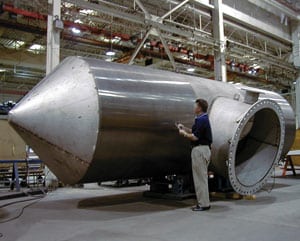
2. Catch and release. A traveling water screen modified to include a low-pressure spray wash and a fish-lifting bucket.
Courtesy: US Filter
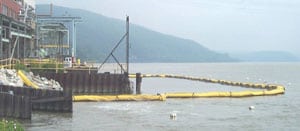
3. Fish-friendly. At the three-unit, 452-MW Lovett Generating Station on the Hudson River, a 1,500-foot-long Marine Life Exclusion System from Gunderboom filters 465 million gallons per day of cooling water.
Courtesy: Gunderboom Inc.
Since one way to comply with the Rule is to have a design intake velocity of 0.5 ft/sec or less, available velocity measurements are presented. We typically identify maximum, normal, and minimum velocities at various locations over the range of plant flows and water levels. In some cases, minor adjustments to the configuration or operation of an intake may be all that is needed to lower the velocity to 0.5 ft/sec.
Construction considerations. During the evaluation process, we identify the appropriate construction techniques for the various alternatives. Some alternatives, such as a shoreline intake with flush-mounted traveling water screen intakes, have to be constructed "in the dry" using earth or sheetpile cofferdams. Other alternatives, such as submerged velocity caps or cylindrical wedgewire screens, can be installed "in the wet" using barge-mounted cranes and divers.
Installation methods are affected by subsurface conditions. The type of material below grade or on a river bottom generally determines the excavation and shoring methods required for foundations. Subsurface materials also dictate the method for anchoring structures to prevent sliding, overturning, or flotation. In addition, subsurface materials will affect the construction effort required for proper installation. Minimal excavation in hard rock will result in more cost-effective structures due to the high cost of rock removal. A soft, clay foundation material will require deep support piles to stabilize the structure.
The construction season is another important factor in the evaluation process. In cold climates, contractors may have to demobilize at the end of a short construction season and mobilize several times to complete construction over several seasons. Work on the water also may be limited by weather conditions. Short construction seasons may require more-costly winter construction to meet a compliance schedule.
O&M considerations. O&M requirements for various types of intakes are an important factor in evaluating alternatives. Operating parameters include electric power for trash rakes, traveling water screens, or screen wash pumps.
Head losses that affect plant performance and fish bypass flows associated with technologies that require additional screening or pumping costs are addressed in the AIA. Maintenance parameters that must be considered include manpower for inspection and routine maintenance.
The addition of new intake openings and pipes to convey flow from a technology to the plant might increase system head losses and water levels at the pumps. Therefore, we size components to minimize head losses and to maintain adequate suction head on the pumps. As a minimum, alternative designs must provide the minimum water level at the pumps that would be acceptable for plant operations.
Clogging by debris, sediment, or ice can reduce flow through an intake structure, increase head losses in the system, and increase hydrostatic forces on the intake. Accordingly, a thorough assessment of clogging potential is an important aspect of the evaluation process.
Finally, the review of potential O&M issues must identify impacts of routine activities on plant operations. Most maintenance activities can be accomplished with the plant operating normally or can be performed during scheduled plant outages. However, some technologies may require portions of the intake to be shut down on a more frequent basis. For example, an inspection of an underwater light/air bubble curtain by divers in a CWIS may require a pump shutdown for safety reasons. These types of impacts on plant operation are identified during the AIA process.
Best biology
During the AIA, Alden uses available biological data, including data developed during prior Section 316(b) studies. Because the Rule requires a numeric reduction in IM&E, it is important to have data on the occurrence and abundance of species susceptible to IM&E.
The first step in the process of developing benefit estimates for alternative CWIS technologies is to estimate the potential biological effectiveness of each alternative selected for detailed evaluation. Such estimates are derived from existing site data, available data from other sites of CWIS application, or other evaluations (for example, laboratory and pilot-scale studies). Ideally, data are available for each alternative under consideration and for each of the numerically dominant species and life stages. However, this is seldom the case. More often, data are available for some species and technologies but are lacking for others.
Direct application is relatively straightforward. For each alternative, the available data are reviewed and a best estimate of potential effectiveness is derived. In many cases, a range of effectiveness values is available for a given species/life stage and technology. A difference in species-specific survival is indicative of the individual species’ relative hardiness.
The reason for differences in effectiveness estimates between study sites is well understood, but the ability to select the best estimate of effectiveness from a range of values in the available data is more complicated, particularly when the range is large. For example, available data on installations of Ristroph-modified screens clearly demonstrate that survival of a given species/lifestage is site-specific. For this reason, the conditions under which a study was conducted and the quality of the study design and resulting data should both be taken into account. Finally, the number of organisms evaluated is a key factor. That is, survival estimates based on substantial numbers of individuals of a given species are likely more accurate than studies observing only a few individuals of that species.
Bring your checkbook
The Rule allows a facility to apply for a reduced performance standard if it satisfies a cost-cost or cost-benefit test. Both tests require a detailed cost estimate of alternative technologies. The next step in the detailed evaluation process is to develop order-of-magnitude project costs for the candidate alternatives. These estimates are based on a conceptual-level design of the CWIS technology. Quantity takeoffs for the major components of the conceptual design, as well as historical data taken from other projects, form the basis of the estimates. Alden takes three kinds of costs into account in the evaluation process.
Design phase costs. Design costs include labor and expenses for engineering services to prepare drawings, specifications, and design documents. We identify these costs as "indirect costs" and estimate them as a percentage (for example, 10%) of the "direct costs" (defined below) for each alternative.
Construction phase costs. Construction costs typically include:
- The direct costs of material and labor.
- Distributable costs for site supervision, temporary facilities, and equipment rental.
- Support services incurred by contractors during construction.
- The facility owner’s costs for administration of project contracts and for engineering and construction management.
- An allowance to cover uncertainties in design and construction.
- A contingency factor to account for possible additional costs that might develop.
Construction typically requires the existing CWIS (and the facility) to be shut down for at least a short period. The duration of the outage depends on the technology being installed and the existing plant design and operating mode. Construction schedules for each alternative are carefully developed to permit sequencing of activities in a manner that minimizes the impact on plant operations and generation revenue. Scheduled plant outages are factored into the installation schedules to the maximum extent possible. The selected sequencing of activities is described in the AIA report in sufficient detail to enable the estimation of construction costs.
O&M costs. Alden considers the costs for normal operation and routine maintenance of the structures and equipment associated with each alternative. We identify operating costs, including labor and power, for all components. Maintenance costs reflect the labor and materials needed to keep the structures and equipment operating to meet the intended design functions and thereby maintain IM&E reduction compliance.
The evaluation includes the material and equipment replacement costs of all activities, as well as the cost of the power required to operate the equipment. The power required to operate the equipment varies widely among technologies and is influenced by site-specific factors.
—Jonathan Black can be reached at jblack@aldenlab.com.







